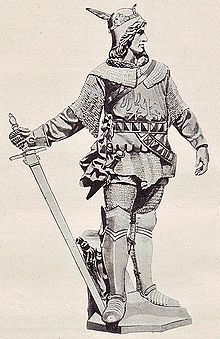Waldemar, Margrave of Brandenburg-Stendal
Waldemar, Margrave of Brandenburg-Stendal | |
|---|---|
 Statue of Waldemar at the Mühlendammbrücke in Berlin, created in 1894/95 by the sculptor Max Unger, prototype for the early monuments in the Siegesallee | |
| Born | c. 1280 |
| Died | 14 August 1319 Bärwalde |
| Noble family | House of Ascania |
| Spouse(s) | Agnes of Brandenburg |
| Father | Conrad, Margrave of Brandenburg-Stendal |
| Mother | Constance of Greater Poland |
Waldemar of Brandenburg (German: Waldemar der Große) (c. 1280 – 14 August 1319, Bärwalde) was Margrave of Brandenburg-Stendal, the last from the Ascanian House.
Life
He was a son of Conrad, Margrave of Brandenburg-Stendal and Constance, daughter of Przemysł I of Greater Poland. Waldemar was co-regent from 1302, and succeeded in 1309 as a guardian for his cousin Henry II, Margrave of Brandenburg-Stendal.

By the Treaty of Soldin (1309), Waldemar relinquished his claims on Pomerelia and Danzig to the Teutonic Order for a payment of 10000 silver Mark. The castle districts Stolpe and Schlawe remained with Brandenburg. These countries, however, were given, together with Rügenwalde, to Duke Wartislaw IV of Pomerania-Wolgast in 1317.
In 1316 he supported Stralsund against Denmark and thereby provoked a large coalition of Denmark, Sweden, Poland, Mecklenburg and the Welfs against himself. He held his position but in the end had to surrender Stargard-Neubrandenburg to Mecklenburg. In 1319 Waldemar acquired Zuellichau and Schwiebus for Brandenburg.
Waldemar was the last governing member of the Brandenburg line of the Ascanian House. In 1309 he married Agnes of Brandenburg (1296–1334), a daughter of Margrave Hermann III. This marriage was childless.
With the death of Waldemar's ward Henry II the Brandenburg branch of the Ascanian House died out in 1320, and Brandenburg fell back to the Empire.
False Woldemar
In 1348, an impostor dubbed "False Waldemar" successfully claimed that he was Waldemar, returning from pilgrimage to the Holy Land after somebody else had been buried in his place. Quickly gaining support due to rivalries, the Emperor reinvested him for about two years before "the last Ascanian" spend his remaining life at the court in Dessau.
Ancestry
| Family of Waldemar, Margrave of Brandenburg-Stendal | ||||||||||||||||||||||||||||||||||||||||||||||||||||||||||||||||||||||||||||||||||||||||||||||||||||||||||||||||||||||||||||||||||||||||||||||||||||||||||||||||||||||||||||||||||||||||||||||||||||||||||||||||||||||||||||||||||||||||||||||||||||||||||||||||||||||||||||||||||||||||||||||||||||||||||||||||||||||||||||||||||||||||||||||||||||||||||||||||||||||||||||||||||||||||||||||||||||||||||||||||||||||||||||||||||||||||||||||||||||||||||||||||||||||||||||||||||||||||||||||||||||||||||||||||||||||||||||||||||||||||||||||||||||||||||||||||||||||||||||||||||||||||||||||||||||||||||||||||
|---|---|---|---|---|---|---|---|---|---|---|---|---|---|---|---|---|---|---|---|---|---|---|---|---|---|---|---|---|---|---|---|---|---|---|---|---|---|---|---|---|---|---|---|---|---|---|---|---|---|---|---|---|---|---|---|---|---|---|---|---|---|---|---|---|---|---|---|---|---|---|---|---|---|---|---|---|---|---|---|---|---|---|---|---|---|---|---|---|---|---|---|---|---|---|---|---|---|---|---|---|---|---|---|---|---|---|---|---|---|---|---|---|---|---|---|---|---|---|---|---|---|---|---|---|---|---|---|---|---|---|---|---|---|---|---|---|---|---|---|---|---|---|---|---|---|---|---|---|---|---|---|---|---|---|---|---|---|---|---|---|---|---|---|---|---|---|---|---|---|---|---|---|---|---|---|---|---|---|---|---|---|---|---|---|---|---|---|---|---|---|---|---|---|---|---|---|---|---|---|---|---|---|---|---|---|---|---|---|---|---|---|---|---|---|---|---|---|---|---|---|---|---|---|---|---|---|---|---|---|---|---|---|---|---|---|---|---|---|---|---|---|---|---|---|---|---|---|---|---|---|---|---|---|---|---|---|---|---|---|---|---|---|---|---|---|---|---|---|---|---|---|---|---|---|---|---|---|---|---|---|---|---|---|---|---|---|---|---|---|---|---|---|---|---|---|---|---|---|---|---|---|---|---|---|---|---|---|---|---|---|---|---|---|---|---|---|---|---|---|---|---|---|---|---|---|---|---|---|---|---|---|---|---|---|---|---|---|---|---|---|---|---|---|---|---|---|---|---|---|---|---|---|---|---|---|---|---|---|---|---|---|---|---|---|---|---|---|---|---|---|---|---|---|---|---|---|---|---|---|---|---|---|---|---|---|---|---|---|---|---|---|---|---|---|---|---|---|---|---|---|---|---|---|---|---|---|---|---|---|---|---|---|---|---|---|---|---|---|---|---|---|---|---|---|---|---|---|---|---|---|---|---|---|---|---|---|---|---|---|---|---|---|---|---|---|---|---|---|---|---|---|---|---|---|---|---|---|---|---|---|---|---|---|---|---|---|---|---|---|---|---|---|---|---|---|---|---|---|---|---|---|---|---|---|---|---|---|---|---|---|---|---|---|---|---|---|---|---|---|---|---|---|---|---|---|---|---|---|---|---|---|---|---|---|---|---|---|---|---|---|---|---|---|---|---|---|---|---|---|---|---|---|---|---|---|---|---|---|---|---|---|---|---|---|---|---|---|---|---|---|---|---|---|---|---|---|---|---|---|---|---|---|---|---|---|---|---|---|---|---|---|---|---|---|---|---|---|---|---|---|---|---|---|---|---|---|---|---|---|---|---|---|
| ||||||||||||||||||||||||||||||||||||||||||||||||||||||||||||||||||||||||||||||||||||||||||||||||||||||||||||||||||||||||||||||||||||||||||||||||||||||||||||||||||||||||||||||||||||||||||||||||||||||||||||||||||||||||||||||||||||||||||||||||||||||||||||||||||||||||||||||||||||||||||||||||||||||||||||||||||||||||||||||||||||||||||||||||||||||||||||||||||||||||||||||||||||||||||||||||||||||||||||||||||||||||||||||||||||||||||||||||||||||||||||||||||||||||||||||||||||||||||||||||||||||||||||||||||||||||||||||||||||||||||||||||||||||||||||||||||||||||||||||||||||||||||||||||||||||||||||||||
External links
- www.genealogie-mittelalter.de
- Absatz Der falsche Waldemar aus Artikel Waldemar von Brandenburg in der Allgemeinen Deutschen Biographie (ADB), Bd. 40, Seiten 682-687
- Artikel zum Waldemar-Bluff
- Roman von Alexis
